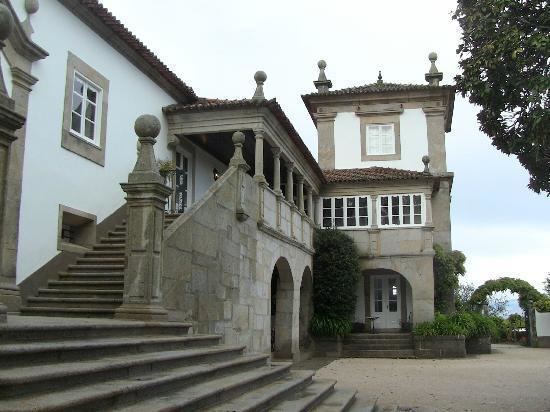Area 8.89 km² Owner Portugal | Municipality Ponte de Lima | |
 | ||
The Palace of Calheiros (Portuguese: Paço de Calheiros) is a 17th-century Baroque manorhouse and tourist guesthouse located in the civil parish of Calheiros, municipality of Ponte de Lima, in the northern region of Portugal.
Contents
Map of Calheiros, Portugal
History
On 5 February 1336, King D. Afonso IV conceded to Martim Martins, the lands of Quinta de Calheiros (the Estate of Calheiros), which was signed as the Paço velho or Quinta do Pinheiro. The lands would become associated with the Quinta de Calheiros, and its principal residents, the nobles who lived at the manor known as the Calheiros.
A letter from King D. John I donated the tower of Santo Estêvão da Facha to squire Garcia Lopes on 21 May 1385, for his support of the conquest of the Castle of Neiva and the town of Ponte de Lima. A year later, on 5 January 1386, he was also conceded all the possessions of Lopo Gomes de Livra, but later donated to Rui Mendes de Vasconcelos, then Fernão Anes de Lira.
A tombstone alongside the main gate dates to 1450.
On 4 August 1528, Fernão Anes de Lima, great-great-grandson of obtained a letter to the coat-of-arms and lands of Calheiros.
The old tower of Santo Estêvão was demolished sometime in the 17th century, just prior to the actual construction of the palace/manorhouse in 1700, likely by Francisco Jácome Calheiros.
Another grave marker, alongside the gate, was reformed by F.L. de Calheiros e Menezes.
Following the establishment of the First Portuguese Republic in 1910, the palace fell into ruin.
The manorhouse was opened to tourism and guests, although the building is still retained by the Count of Calheiros (Francisco Silva de Calheiros e Menezes in the late 20th century).
Architecture
The manor is situated in an isolated rural hilltop, implanted in the agricultural lands of the estate, its principal facade oriented to the south to the various cultivated lands and the Lima valley. The estate is encircled by high walls, while the main gate is surmounted by sculpted vases and flanked by three grave markers (one in bronze). A laneway of trees leads to the main circular fountain on the estate, while to the left of the laneway there is another fountain addorsed to the wall and crowned by "balls" and a cross with two spouts and coat-of-arms and rectangular tank.
The irregular, rectangular plan consisting of two facades: a frontispiece, that forms a gentle "U"-shape with central chapel acting as annex, a square tower in the extreme southwest, that compliments another symmetrical tower, and articulated volumes of roof tile. The two-storey frontispiece is divided into three sections, with the left unit simple with windows and framed doorways and cornerstones. The central section, is inset, preceded by a three-flight staircase with two wings that connect to various sections. In it is the chapel, marked on the exterior by a cornice over pilaster and bell tower with cross over tile, surmounted by rectangular door interrupted by a frontispiece and window. The chapel includes a high-choir and retable with gilded woodwork. The third section is partially aligned with the second section, is formed by a covered varanga, with columns over two arches, forming an angle and addorsed by one of the towers. The lateral right facade has a central wing consisting of two storeys, separated by friezes with three doors and three low windows on the first floor and windows surmounted by cornices on the second. The square towers on the extremes are three-storeys tall, separated by friezes with fenestrations on the first and second floors, similar to the central wing, and high windows on the third storey. Balls over plinths accentuate the cornerstones and pilasters.
Near the facade, in a lower terrace is the private gardens, marked by a central circular fountain. These gardens were classified as a historic structure by the Associação Portuguesa dos Jardins Históricos (Portuguese Association of Historic Gardens). In addition, the garden includes a swimming pool, a tennis court and other tourist installation expanded during the course of transforming the site for tourist lodging. In addition, there is a large vineyard that produces local Vinho Verde, supported by varieties of Loureiro (white) and the Vinhão (red), both typical of the region.
